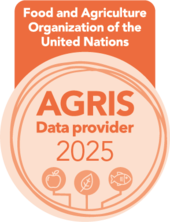Evaluación del efecto sobre el rendimiento y calidad del fruto de dos métodos de injerto en sandía (Citrullus lanatus Thunb) en costa central de Perú
DOI:
https://doi.org/10.17268/manglar.2020.013Resumo
La sandía (Citrullus lanatus Thunb.) es una planta de la familia de las cucurbitáceas cuyo cultivo se está desarrollando aceleradamente, siendo las zonas costeras del país las más relevantes. En la familia Cucurbitáceas, la técnica de injerto se ha utilizado para mejorar la resistencia a los estreses abióticos, productividad del cultivo y características cualitativas de la fruta. En tal sentido, el presente trabajo evalúa los métodos de injerto por empalme y aproximación en sandía var. Peacok Wr 24 (Citrullus lanatus Thunb) injertada sobre Lagenaria siceraria y su efecto sobre el rendimiento y calidad del fruto. El peso del fruto, número de fruto por planta, firmeza de la pulpa, grados brix y rendimiento fueron evaluados, encontrándose diferencias significativas en el contenido de azúcares medido por grados brix cuando el cultivo fue injertado por aproximación. Si bien hubo un incremento en el rendimiento en los frutos de tercera categoría cuando se usó el injerto por aproximación, este no superó los valores en los frutos de primera categoría. En conclusión, los métodos de injerto no aumentaron el rendimiento y calidad del fruto, pero brindaron mayor vigor a la planta y ayudaron en su tolerancia a enfermedades.
Downloads
Referências
Abd El-Wanis, M.; El-Eslamboly A.A.S.A.; Salama, M.A. 2013. Impact of different grafting methods on yield and quality of watermelon. Research Journal of Agriculture and Biological Sciences 9(6): 330-340.
Bekhradi, F.; Kashi, A.; Delshad, M. 2011. Effect of three cucurbits rootstocks on vegetative and yield of 'Charleston Gray' watermelon. International Journal of Plant Production 5(2): 105-110.
Colla, G.; Rouphael, Y.; Cardarelli, M.; Salerno, A.; Rea, E. 2010. The effectiveness of grafting to improve alkalinity tolerance in watermelon. Environmental and Experimental Botany 68(3): 283-291.
Crawford, H. 2017. Manual de manejo agronómico para el cultivo de sandía. Instituto de Investigaciones Agropecuarias (INIA-Chile). Disponible en: http://www.inia.cl/wp-content/uploads/Manual de Producción/ 02%20Manual 1%20 sandia.pdf.
Davis, A.R.; Perkins, P. 2005. Rootstock effects on plant vigor and watermelon fruit quality. Cucurbit Genetics Cooperative Report 28-29: 39-42.
Fallik, E.; Ziv, C. 2020. How rootstock/scion combinations affect watermelon fruit quality after harvest? J Sci Food Agric. Accepted Author Manuscript.
Hassell, R.L.; Memmott, F.; Liere, D.G. 2008. Grafting methods for watermelon production. HortScience 43(6): 1677-1679.
Innova seeds. 2018. Sandía Peacocks wr 124. Disponible en: http://www.innovaseeds.com/espanol/productos/techsheets/sandía/Peacockwr124.pdf.
Kurum, R.; Çelik, İ.; Eren, A. 2017. Effects of rootstocks on fruit yield and some quality traits of watermelon (Citrullus lanatus). Derim 34(2), 91-98.
Kyriacou, M.C.; Rouphael, Y.; Colla, G.; Zrenner, R.; Schwarz, D. 2017. Vegetable Grafting: The Implications of a Growing Agronomic Imperative for Vegetable Fruit Quality and Nutritive Value. Frontiers in Plant Science 8: 741.
Kyriacou, M.C.; Soteriou, G. 2015. Quality and Postharvest Performance of Watermelon Fruit in Response to Grafting on Interspecific Cucurbit Rootstocks. Journal of Food Quality 38(1): 21–29.
Lee, J.M.; Oda, M. 2010. Grafting of Herbaceous Vegetable and Ornamental Crops. In Horticultural Reviews 28: 61-124.
López-Marin, G.J.; Porras, A.I.; Brotons, M.JM. 2016. Injerto en pimiento (Capsicum annuum): Beneficios y rentabilidad de su uso. Informacion Tecnica Economica Agraria 112(2): 127-146.
Louws, F.J.; Rivard, C.L.; Kubota, C. 2010. Grafting fruiting vegetables to manage soilborne pathogens, foliar pathogens, arthropods and weeds. Scientia Horticulturae 127(2): 127-146.
MINAGRI- Ministerio de Agricultura y Riego. 2018. Disponible en: https://www.gob.pe/minagri
Mohamed, F.; El-Hamed, K.; Elwan, M.; Hussien, M.A. 2012. Impact of Grafting on Watermelon Growth, Fruit Yield and Quality. Vegetable Crops Research Bulletin 76(1): 99-118.
Moreno, M. M.; Villena, J.; González-Mora, S.; Moreno, C. 2019. Response of healthy local tomato (Solanum lycopersicum L.) populations to grafting in organic farming. Scientific Reports 9(1): 4592-4602.
Oda, M. 1990. Grafted Plant “Tomapena” Produces Three Different kinds of fruit in one plant. Tochigi, Japan: Japan Tobacco Plant Research Institute, 108 pp.
Orrala-Borbor, N.; Herrera-Isla, L.; Balmaseda-Espinosa, C. 2018. Rendimiento y calidad de la sandía bajo diferentes patrones de injerto y dosis de NPK. Cultivos Tropicales 39(3): 25-30.
Rivero, R.M.; Ruiz, J.M.; Romero, L. 2003. Can grafting in tomato plants strengthen resistance to thermal stress? Journal of the Science of Food and Agriculture 83(13): 1315-1319.
SAS, 2006. Statistical Analysis Sistem. SAS Institute Inc. Version 9. North Caroline. USA.
Savvas, D.; Colla, G.; Rouphael, Y.; Schwarz, D. 2010. Amelioration of heavy metal and nutrient stress in fruit vegetables by grafting. Scientia Horticulturae 127(2): 156-161.
Soto, C.F.; Soto M.J. 2017. Rendimiento y calidad de once híbridos de sandía (Citrullus lanatus), bajo las condiciones de la Molina. Tesis de Ingeniero agrónomo, Universidad Nacional Agraria la Molina, Lima. Perú. 49 pp.
Suárez-Hernández, A. M.; Grimaldo-Juárez, O.; García-López, A.M.; González-Mendoza, D.; Huitrón-Ramírez, M.V. 2017. Evalua-ción de portainjertos criollos de Lagenaria siceraria en la producción de sandía injertada. Idesia (Arica) 35(1): 39-44.
Suchoff, D.H.; Schultheis, J.R.; Gunter, C.C.; Hassell, R.L.; Louws, F.J. 2019. Effect of rootstock and nitrogen fertilizer on growth and yield in watermelon. Journal of Horticultural Science and Biotechnology 94(6): 798-804.
Tokgöz, H.; M. Gölükcü; R. Toker; D.Y. Turgut. 2015. Effects of grafting and harvesting time on some physical and chemical parameters of watermelon (Citrullus lanatus). Gıda 40(5): 263-270.
Tripodi, G.; Condurso, C.; Cincotta, F.; Merlino, M.; Verzera, A. 2020. Aroma compounds in mini-watermelon fruits from different grafting combinations. Journal of the Science of Food and Agriculture 100(3): 1328-1335.
Downloads
Publicado
Edição
Secção
Licença

Manglar is an open access journal distributed under the terms and conditions of Creative Commons Attribution 4.0 International license









